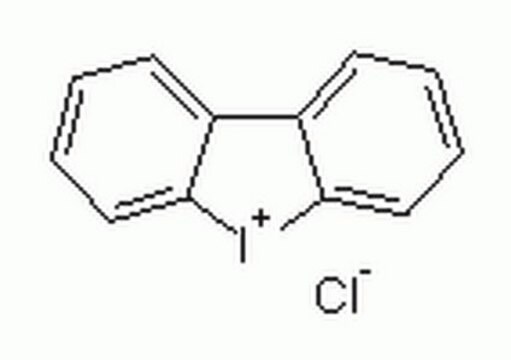D2926
Diphenyleneiodonium chloride
≥98%
Synonym(s):
DPI, Dibenziodolium chloride
About This Item
Recommended Products
Quality Level
assay
≥98%
form
powder
mp
278 °C
solubility
DMSO: 9.80-10.20 mg/mL, clear, colorless to faintly yellow
storage temp.
room temp
SMILES string
[Cl-].[I+]1c2ccccc2-c3ccccc13
InChI
1S/C12H8I.ClH/c1-3-7-11-9(5-1)10-6-2-4-8-12(10)13-11;/h1-8H;1H/q+1;/p-1
InChI key
FCFZKAVCDNTYID-UHFFFAOYSA-M
Gene Information
human ... NOS1(4842) , NOS2(4843) , NOS2B(201288) , NOS2C(645740) , NOS3(4846)
mouse ... Pik3r1(18708)
Looking for similar products? Visit Product Comparison Guide
Application
- to study its effects on the reactive oxygen species (ROS) levels and also its inhibitory effects on killing tumor cells by neutrophils isolated from clinical malignant pleural effusion (MPE) samples
- as a nicotinamide adenine dinucleotide phosphate (NADPH) oxidase inhibitor to confirm the variation in inflammation was secondary to overproduction of reactive oxygen species (ROS) in cells treated with doxorubicin (DOX) + flagellin (FL)
- as an NADPH oxidase (NOX) inhibitor to study its effects on palmitate (PA)-induced sphere-forming ability of HepG2 (hepatocellular carcinoma) cells
Biochem/physiol Actions
Storage Class
11 - Combustible Solids
wgk_germany
WGK 3
flash_point_f
Not applicable
flash_point_c
Not applicable
ppe
Eyeshields, Gloves, type N95 (US)
Certificates of Analysis (COA)
Search for Certificates of Analysis (COA) by entering the products Lot/Batch Number. Lot and Batch Numbers can be found on a product’s label following the words ‘Lot’ or ‘Batch’.
Already Own This Product?
Find documentation for the products that you have recently purchased in the Document Library.
Customers Also Viewed
Articles
DISCOVER Bioactive Small Molecules for Nitric Oxide & Cell Stress Research
Our team of scientists has experience in all areas of research including Life Science, Material Science, Chemical Synthesis, Chromatography, Analytical and many others.
Contact Technical Service








